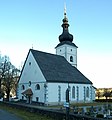Pilgrimage Church of Maria Elend
The pilgrimage church Maria Elend im Rosental ( Slovenian : Marijina romarska cerkev v Podgorjah v Rožu ) is a Roman Catholic Church of St. Mary in the village of Maria Elend in the Carinthian municipality of Sankt Jakob im Rosental . In a Maria Misery Church , the flight to Egypt from the child murderer Herod is commemorated; this incident is part of the second of seven sorrows of Mary . The feast of patronage is therefore celebrated on the feast day of the Seven Sorrows of Mary , September 15th .
history
It was built by the Ossiach Benedictines after 1267, when they received archdeaconate rights over the upper Rosental valley. It was destroyed during two Turkish invasions in 1478 and 1483. The north Italian bishop Pietro Carlo ( Caorle ) inaugurated the reconstruction in 1486. The church received its current form in the years 1682–1690 under Abbot Edmund Ibelbacher (Benedictine Abbey Ossiach); During this time, the ships were also lengthened and their vaulting.
church
The building is a three-aisled Gothic hall church with considerable baroque modifications; the three ships each have the same dimensions and are vaulted with a barrel and caps. The two outer aisles are Gothic, the windows show Gothic tracery ; the central nave comes from different construction periods. The oldest part of the church is the ground floor of the massive square Romanesque tower, which in its current form is 49 m high.
Church interior design
The church is equipped with a baroque high altar , the main part of which is a votive offering from the city of Vienna ; she donated it as thanks for her liberation from the Second Turkish Siege of Vienna (1683). In some places on the altar there are references to the foundation motif - Turkish heads and crescent moons . The high altar, whose central image " Mother of God with Jesus Child " consists of marbled wood with gold and color painting, was completed in its current form around 1731 by the Klagenfurt painter Johann Marcell Singer.
In a yoke in front of the choir there is an inscription ("HIC THRONVS GRATIARVM QVO AB ANGELIS VIRGO DEPORTARI VOLVIT MDCLLVVVVVVIIIIII" - "Here (stands) the throne of grace, from which the Virgin wanted to be carried away by the angels 1736.")
The relatively small church is equipped with an astonishing number of artistically valuable altars. The late Gothic winged altar , which is located in the south aisle, is a particular treasure . It dates from around 1515 and was probably created by artists from the Villach School under the aegis of Lukas Tausmann . Particularly noteworthy is its filigree ornamental carving , which makes it one of the most beautiful altars of its time. During Lent the wings of the altar were closed; Then motifs from the Passion of Jesus Christ can be seen in late Gothic paintings, as well as depictions of the Fourteen Holy Helpers , whose veneration was widespread in times of the plague , the Turkish wars and social hardship.
In addition to this treasure, another four side altars and a baroque pulpit enrich the interior.
- Scapular altar . The altar was donated in 1732 by the Rosegger burgrave Georg Nikolaus Orsini-Rosenberg . Motif (painting): Delivery of the scapular by the Virgin Mary to the General of the Carmelite Order Simon Stock (1165–1265).
- Anthony Altar . In addition to the late Baroque winged altar, it is the oldest in the church; originally it was designed as a Marian altar, as an inscription shows. It was donated around 1650 by the Benedictine abbot Hirschberger from Ossiach. Motif (painting): Anthony of Padua prays before the apparition of the baby Jesus.
- Johannes Nepomuk Altar . Here, too, is probably a foundation from the Ossiach Benedictine Abbey , which was made in 1733. Central motif (painting): Adoration of the crucified Christ by the saint.
- Altar of Saint Joseph . It is located on the east wall of the north aisle and dates to the 17th century; its provenance is not known. Motif (painting): Joseph leads the baby Jesus by the hand.
- Baroque pulpit . The pulpit is a donation from Count Georg Orsini-Rosenberg . It bears the year 1745 and the coat of arms of the donor family. The pulpit is characterized by an abundance of extremely filigree carvings with lavish gold decorations. Central motif: Christ as the Good Shepherd , flanked by the apostles Simon Peter and Paul .
- Four monochrome fresco medallions by Josef Ferdinand Fromiller in the presbytery .
Photo gallery
Web links
- Parish Maria Elend / Podgorje on the website of the Diocese of Gurk
- Church guide (PDF, in German and Slovenian; 957 kB)
See also:
- Maria-Elend-Kirche (list)
Notes and individual references
- ↑ The day of patronage in the Catholic liturgical calendar is September 15th.
Coordinates: 46 ° 31 '44.8 " N , 14 ° 4' 59.2" E







